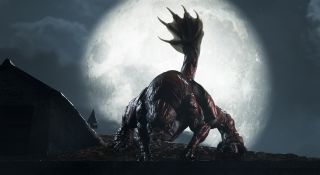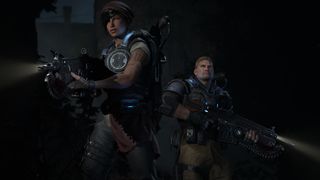Gears of War 4 is smaller, smarter, and more scary
War never changes, apparently. Gears of War though, really, really did. Appearing in 2006 as a taught, demanding, horror-tinged cover shooter, it redefined third-person combat as radically as its own inspiration, Resident Evil 4, had done before it. Typified by tension, tactics, and an ever-ferocious tug-of-war for space and momentum, Gears of War is tuned in a way that forces the player to grasp a knife-edge of aggression and defence, hang on, and try their damnedest to not bleed out along the way.
Gears 2 maintained largely the same conceits, but upped the scale slightly, moving the narrative on from the first game’s tale of behind-enemy-lines survival to a dogged fight back. The difference between Predator and Aliens, effectively, but wrapped in a game that still had oppression and precision at the forefront of its design. Gears 3 though, upped everything, doubling the campaign co-op cap to four, exploding the size of the skirmish areas, and flooding its battles with a slew of new tentacle-whipping, goop-splurging, exploding enemies that changed the series’ whole vibe and flow.
Opinion has long been split on how successful Gears 3’s escalation was, some seeing it as the natural evolution of the series, others finding it a bloated betrayal of the values that made Gears of War so striking in the first place. But now things have changed again, and Gears of War is going right back to the start, for a whole new, entirely more intimate beginning.
We have a new Xbox, a new developer, and a new era in the Gears of War story. Series creator Epic Games has departed, and the now wholly Microsoft-owned franchise is being shepherded by built-for-purpose studio The Coalition. The team is headed by Rod Fergusson, previous Gears producer at Epic, and the man pulled in to help BioShock Infinite during its late development. After the series’ drastic, last-gen escalation culminated in score-attack spin-off Gears of War: Judgment, for a long time it was hard to fathom exactly what form Gears 4 might take. Indeed, Fergusson tells me that many options were discussed.
“We could have done a prequel, but if you look at it, anything before Gears 1 is completely human on human. It’s the Pendulum Wars. And Gears of War is a monster game. If you don’t have a monster, I don’t think you have Gears, and so that made no sense. And eventually we hit our head against the beginning of Gears 1, where we have to put Marcus in the jail, and that’s where our story ends.

“So we felt like a prequel wasn’t the right answer, and we talked about a reboot, and we were like ‘You know what? It feels disrespectful for The Coalition to get this franchise and then decide to tell our own version of it. You didn’t like that one, look at ours’. We didn’t want to do the Spider-Man thing, right?”
Eventually, a pure sequel was decided upon, and the decision made to add 25 years to the timeline in order to pick up with a new generation, both within and outside the game. Fergusson states that this was the result of doing things “the right way” rather than “the easy way”, the studio dropping the cheap option (“It’s Delta Squad against Locust. You didn’t get them all, they’re back, it’s six months after Gears 3, aaaand go”) in favour of a set-up that blends familiarity with freshness, delivering a jumping-on point for players who might have been too young the first time around, and leaving the new team plenty of headroom to grow its own series.
Sign up to the 12DOVE Newsletter
Weekly digests, tales from the communities you love, and more
But the ‘back-to-square-one’ ethos doesn’t simply pander to the desire for the room to tell a fresh tale. It also sprang from The Coalition’s need to create not just a new Gears of War game, but a new Gears of War saga. With Gears 3 having already maxed out the scale of the series’ first iteration, any attempt to go further would have been foolhardy, particularly when picking up the mantle for the first time.

“When we looked at where Gears 3 went to, we had such a large cast, we had such a large set of enemies, such a large set of weapons, large everything. To try to take this new team with new tech, and all the new risks that are with this product, and go ‘We’re going to do even bigger than Gears 3!’, it was just impossible. And plus, it’s just not where we want to go fictionally, from a story perspective. We want to get back to ‘How do we make you afraid again?’. So we went back to intimate [designs], we went back to three people surviving the night, and that’s what this is.”
Not that everyone at Microsoft seemed to understand the situation at first, as Fergusson recounts. “It was funny when we worked with Marketing. They said ‘Oh here’s our back-of-the-box copy’, and it’s like ‘IN A WORLD WHERE…’ [laughs] It’s this big Gears of War thing again, And I’m like, ‘Guys guys guys, not yet, not yet.”
That theme of fear keeps coming back up as we discuss the new game. Many were rather confused by Gears 4’s ‘reveal’ at E3 2015, delivered by way of a slow, dark gameplay demo that took in more ominous, shadowy exploration than combat. But while that demo was apparently never intended to be indicative of how the game will play, tonally it was very much in step with what Gears of War 4 intends to deliver. Regardless of its later – erroneous – reputation as a big, dumb, bro shooter, the original Gears was one hell of a scary game, its fraught combat matching a brutally hopeless atmosphere to prove that scary shooters don’t begin and end with the likes of Resident Evil.

“Whenever somebody uses the word ‘horror’, people go ‘Survival Horror!’”, laments Fergusson. “It’s not Survival Horror, I’m a big man with a chainsaw gun. I’m not walking backwards down a hallway, scared, right? What I go back to is the word ‘tense’. There’s a darkness and a tenseness to the tone of Gears 1. That’s what we’re trying to return to with Gears of War 4.
“We want you to be afraid again. We want it to be [a situation where] one monster is something to be scared of. Not where it has to be ‘I need 30 monsters to be afraid’. We want it to be ‘one’s enough’, and look at how you get back to that. And if you have an army of 12 people with you, that’s hard to do.”
That brings us on to Gears of War 4’s conspicuously different approach to its cast of playable characters. There are just three protagonists, JD ‘Son of Marcus’ Fenix, and his friends Kait and Del. The trio are AWOL from the Coalition of Ordered Governments, which has imposed martial law in order to deter Sera’s dwindling population from leaving the walled cities it has set up in the environmental aftermath of Gears 3’s climactic genocide.
Once more, we have a small, close team, cast out into the dark of a dangerous world, with presumably little in the way of outside help. With the co-op limit also reflecting the first game, with its reduction to two players, max, it’s worth noting that Gears 4 is going even further to recreate the oppressive vibe that made the original so affecting. Its cast is not only smaller in number, but in stature too. These three aren’t the walking refrigerators we expect from Gears of War, but something altogether more relatable.

“Our Art Director uses this term ‘heroic authenticity’, Fergusson explains. “It’s this notion of recognising that Gears’ art style needs a certain stylisation to allow for that heroic feel to the characters, to make them larger than life. But one of the things he wanted to look at was ‘How do we make it a little more believable?’ So when you look at the previous games, they were in shin-high, steel boots to run around, and it took the science fiction part a little further. When you look at [our guys] they actually wear normal combat boots, and that kind of stuff. That was a big part of the art design. ‘How do we get the proportions down without going realistic? How do we bring it down to being a little more believable?’”
The method certainly works. Even just when playing Gears 4’s multiplayer component – soon to be available in a beta - it’s striking how much more vulnerable its characters feel than Marcus and company. The slighter frames, alongside the increase in fabric attire and exposed flesh, reinforces the sense that these are fragile, easily perforated people rather than bipedal tanks with grimacing faces. They feel naive, and out of their depth. They feel like they’re just not ready for any of this.
In short, they feel exactly like we all unwittingly were back in 2006, before Gears of War punched us rudely between the eyes with a whole new, entirely more imposing kind of warfare. Ten years and three sequels later, many might expect the delivery of a second such impact to be an impossible feat. But if Gears of War 4 can realise its well-considered aspirations, it might just be in with a chance of beating those odds.













